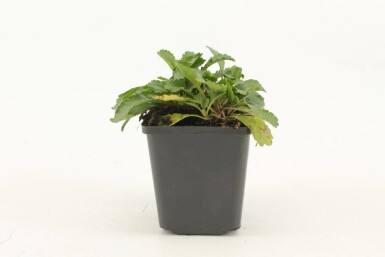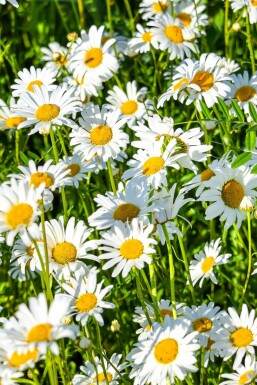





Updated on 10 September 2025
We regret to inform you that we are currently unable to ship orders to the United Kingdom. We anticipate being able to resume shipments at the beginning of 2026.
Leucanthemum, with its daisy-like white flowers and yellow centre, creates a summery look in any garden. Perfect for summer borders and bee gardens, this low-maintenance plant attracts bees and butterflies, and is ideal for cut flowers and natural settings.
Leucanthemum brings a touch of classic charm to any garden. Known for its dark green serrated leaves and sturdy stems, it dazzles with white rays surrounding yellow conical hearts. Its long bloom period, from early to late summer, ensures a continuous display of beauty. Leucanthemum daisy is perfect for summer borders and makes an excellent cut flower. As a perennial, it invites bees and butterflies, enhancing a cottage garden's appeal. Discover the joy of having this ox-eye daisy in your garden and imagine the lively atmosphere it creates. Consider adding this classic white border plant for a simple yet elegant transformation. Whether planting in borders or buying for a bee-friendly garden, this long-flowering perennial offers endless possibilities.
Leucanthemum, commonly known as the oxeye daisy, is a perennial plant with distinct white petals and yellow centres. Unlike wild daisies, it is part of the Asteraceae family. Often referred to as the ox-eye daisy or Leucanthemum daisy, it is also known as the meadow daisy and classic white bloomer. This plant is widely used in gardens for border planting, group planting, and as a cut flower. The Leucanthemum originated in Europe and Western Asia but is now seen in gardens worldwide due to its versatility. The oxeye daisy plays an important ecological role, offering nectar to bees, beetles, and butterflies. It also provides seeds for birds. The name 'Leucanthemum' comes from the Greek words 'leukos' for white and 'anthemon' for flower, symbolising innocence and motherhood. With a life cycle of a perennial or short-lived plant, it thrives in sunlight, resists deer, and self-seeds easily. This robust plant tolerates poor soil and is a favourite for gardeners looking to buy Leucanthemum in the UK or add white border perennials to their garden.
The Leucanthemum, known for its charming daisy-like white flowers with a yellow centre, showcases spatulate, slightly toothed leaves in fresh to dark green shades. The foliage is finely divided, helping to reduce evaporation, making it quite drought-tolerant and well-suited for areas with dry conditions or rough grasslands. This perennial is hardy, thriving in USDA zones 4 to 6 and enduring temperatures as low as -34°C. It's an excellent choice for gardens seeking resilience, as it will bloom abundantly from May to September, creating a lively summery look. The Leucanthemum maintains its leaves throughout winter, providing greenery year-round, depending on the local climate and garden positioning. When it comes to hot and dry conditions, Leucanthemum adapts well due to its efficient leaf structure and ability to reseed, ensuring continuous growth even in challenging environments. It's non-toxic, making it safe for both children and pets, ideal for family gardens. Furthermore, it contributes significantly to biodiversity by attracting pollinators with its extended blooming period and creating a natural habitat for various insects. This enhances the garden ecosystem, increasing resistance to potential pests. For those looking to grow Leucanthemum superbum in the UK, or considering dividing daisy clumps, this plant offers both aesthetic appeal and ecological benefits, making it a classic choice for any garden enthusiast.
Leucanthemum, commonly known as oxeye daisy, offers a variety of applications in the garden. It is a versatile perennial that can enhance both natural and formal borders.
Leucanthemum offers a stunning display in the garden when combined with various plant types and species. Pairing Leucanthemum with Achillea creates a harmonious blend of white and vibrant yellow, enhancing summer borders. Campanula's delicate blue flowers contrast beautifully with the classic white blooms of Leucanthemum, while Echinacea's striking pink adds depth and interest to the garden design. Coreopsis, with its sunny yellow flowers, complements the long-flowering perennial nature of Leucanthemum. Stachys, with its soft, silvery leaves, adds texture and a soothing backdrop. These plant combinations with Leucanthemum are excellent for creating a bee and butterfly-friendly garden. The Leucanthemum daisy bloom attracts pollinators, making it a perfect choice for summer displays. Combining these plants enriches the garden's biodiversity, offering nectar and habitat for visiting insects. Leucanthemum is a classic daisy loved among bee plants. Its versatility in summer borders and its role as a cut flower make it a valuable addition. Together, these combinations provide a rich tapestry of colour and life, ensuring a vibrant and lively garden setting.
Leucanthemum, commonly known as meadow daisy, thrives best in full sun. It requires at least 6 hours of sunlight each day for optimal growth. A location with ample sunlight ensures these plants produce their classic white bloomer flowers. However, protection from strong winds is important as it can limit growth. Using a windbreak, such as a hedge, can help reduce exposure. The ideal soil for Leucanthemum is neutral to calcareous, well-drained grassland soil. Regularly adding compost helps maintain nutrient levels, promoting lush blooms. Ensuring well-drained soil prevents waterlogging, which can stunt growth. While drought-tolerant, Leucanthemum prefers moderately moist conditions. Adequate watering during dry spells keeps the soil from drying out excessively, especially in full sun areas. Leucanthemum prefers a neutral to slightly alkaline pH level. Testing soil pH can ensure it suits the plant's needs. Adjusting with lime can balance pH if necessary. Keeping these factors in mind helps these perennial daisies thrive, creating a stunning display in any garden, enhancing the appeal of UK gardens. For those looking to enhance their garden with these delightful blooms, consider purchasing Leucanthemum in the UK.
Plant Leucanthemum during spring or late summer for best results. Those in pots can be planted year-round, but avoid frosty periods. Use well-drained, nutrient-rich soil to ensure healthy growth. The plant flourishes in full sun to light shade, needing at least 6 hours of sunlight daily. Space plants according to type and size; check details on the Heijnen product page for exact plant spacing. It's essential to prepare the soil properly. Use Heijnen planting soil, which is nutrient-rich and well-draining, supporting the Leucanthemum's needs. Regularly add compost to nourish the plant. When planting, water the Leucanthemum thoroughly. After planting, ensure it remains moderately moist, especially in dry periods. Remove spent flowers to encourage longer blooms. Consistent care and the right environment will help the oxeye daisy thrive in your garden.
Leucanthemum, known for its charming white flowers with yellow centres, is a delightful addition to any UK garden. These daisies stand tall with an upright growth form, lending an air of elegance. The vibrant, fresh green leaves provide a striking contrast to the blooms, enhancing their appeal. In summer, the oxeye daisy attracts butterflies and is a beautiful butterfly plant. This characteristic makes Leucanthemum a favourite among those who cherish nature-friendly spaces. The daisy-like flowers not only offer aesthetic pleasure but also serve as a food source for bees and butterflies, contributing to the garden's biodiversity. With a robust nature, Leucanthemum thrives even in poor soil and remains deer-resistant, ensuring low maintenance. During autumn, the foliage may display hues that add seasonal interest to the garden. The long-flowering nature of the Leucanthemum daisy bloom ensures it captivates attention throughout the season, making it a classic white border plant. Whether in a cottage garden or a meadow setting, this perennial daisy stands out, offering a timeless display beloved by many.
Leucanthemum, commonly known as the oxeye daisy, is a favourite perennial daisy for gardens. These meadow flowers are cherished for their bright blooms and ease of care. Let's look at some popular varieties that are perfect for those wanting to add these charming white border perennials to their garden.
The Leucanthemum, also known as the oxeye daisy, is a popular choice for many gardens. It offers several benefits that make it a favourite among gardeners. Advantages:
Leucanthemum offers a delightful addition to any garden. With its beautiful white petals, it's perfect for summer borders and cottage gardens. The oxeye daisy is known for its long flowering period from May through September, making it ideal for those who want continuous blooms. When looking to buy Leucanthemum in the UK, consider Heijnen for premium quality plants. Leucanthemum is a strong border plant, attracting bees and butterflies, and requiring little maintenance – perfect for both meadows and borders. Its reseeding habits ensure new growth each season. The oxeye daisy is particularly beneficial for pollinators, providing essential resources during bloom time. Order your cheerful Leucanthemum (Oxeye Daisy) from Heijnen and bring summer simplicity and nostalgia to your meadow or border.
We would like to provide some tips on how to plant and care for a Leucanthemum. By following these tips, you can be sure to enjoy your Leucanthemum for a long time.
Leucanthemum thrives best in a sunny spot with well-drained, neutral to calcareous soil. It enjoys at least 6 hours of direct sunlight daily. The soil should be moderately moist but not waterlogged, as good drainage prevents root issues. Position in areas protected from strong winds for optimal growth. Choosing the right spot boosts its healthy growth and leads to a more vibrant display of blooms. This improves its resistance and gives a richer colour to its leaves. Leucanthemum is adaptable to drought conditions, thanks to its fine divided foliage. Ideal for use in summer borders, it also shines as a cut flower or in bee and butterfly gardens. Plant it in spring or late summer for best results. The right location is crucial for its flourishing, ensuring a longer blooming period and a stunning garden display.
Ground preparation is essential when planting leucanthemum to ensure healthy growth. Begin by working the soil well, ensuring it is nutrient-rich and well-draining. This improves water permeability and provides essential nutrients. Adding organic materials like compost helps mix into existing soil for better results. Proper soil preparation is crucial before planting, especially for plants like the oxeye daisy, which thrives in these conditions. Pot-grown plants can be planted throughout the year, avoiding frost periods. For plants with a jute bag around the root ball, plant them in spring or autumn without removing the jute. Watering the plants after planting is important until they root well. The size of the plant at planting will determine the number needed per square metre. This step ensures the daisies flourish in the garden environment.
Fertilising Leucanthemum is crucial for its growth and bloom. A balanced approach ensures healthy oxeye daisy plants, promoting vibrant white blooms with yellow centres. Use organic fertilisers from Heijnen for good growth and vitality. These natural options enrich the soil without harming the environment. Opt for light fertilisation in spring, with a possible repeat after the first bloom to encourage reblooming. This approach supports the Leucanthemum's overall health, keeping foliage fresh green. The amount of fertiliser depends on plant size; larger plants need more. Ensure fertilisers reach roots by watering during dry spells, allowing nutrients to penetrate the soil. This routine helps the oxeye daisy thrive, supporting its role in borders, group planting, and natural gardens.
Leucanthemum needs regular pruning to thrive. The plant should be pruned to remove dead flowers and encourage continuous blooming. Pruning the oxeye daisy in early spring rejuvenates it and helps remove any dead branches. It's best to prune with sharp secateurs, ensuring clean cuts that promote healthy growth. Regular pruning and dividing every 2–3 years can significantly improve the plant's health and appearance. This helps maintain an attractive, well-shaped plant. In autumn or early spring, cutting back the plant prepares it for the next growing season. Proper tools are essential for effective pruning, as they prevent damage and make the task easier. Overall, paying attention to the pruning routine will enhance the beauty and longevity of the Leucanthemum in any garden.
Leucanthemum requires regular watering, especially in drought. Although it tolerates dry periods, flowering can suffer without adequate moisture. Newly planted Leucanthemum must receive sufficient water to develop strong roots. Once established, watering is only necessary during extended dry spells. It is better to water generously when needed, rather than a little every day. The best time to water is early morning or late afternoon to reduce evaporation. Checking the soil is essential to determine the actual water needs of the plant. Excess water should always have a way to drain away, whether in the ground or in pots. Drip hoses are effective only once the plant is well-rooted, so additional watering is necessary initially. Leucanthemum, like the oxeye daisy, is moderately drought-tolerant but prefers even moisture for optimal growth.
Leucanthemum, known for its bright white petals and vibrant yellow centre, adds a touch of innocence to any garden. This strong border plant is not only visually appealing but also low maintenance. It flowers for a long period and attracts bees, making it a favourite for meadows and borders. The oxeye daisy, symbolising purity, is safe for children and pets, providing beauty without worry.
Leucanthemum benefits from regular division to keep the plant healthy and vibrant. This process involves digging up the plant, carefully removing old parts, and replanting the young sections. It's important to do this every 2-3 years. Dividing helps rejuvenate the plant, allowing it to bloom more profusely. The best time for this is in spring or after flowering in early autumn. Use a garden fork or spade for digging and a sharp knife for dividing. Division not only promotes growth but also prevents overcrowding, leading to better air circulation. Make sure to replant in well-drained soil, giving the young plants plenty of space to thrive. Regular care ensures the leucanthemum remains a stunning addition to any garden.
The oxeye daisy is a strong border plant with dark green serrated leaves and sturdy stems. It blooms from early to late summer, displaying white flowers with yellow centres. This perennial daisy is low maintenance and attracts bees, beetles, and butterflies, making it perfect for meadows and borders. Order your cheerful Leucanthemum (Oxeye Daisy) from Heijnen and bring summer simplicity and nostalgia to your garden.
